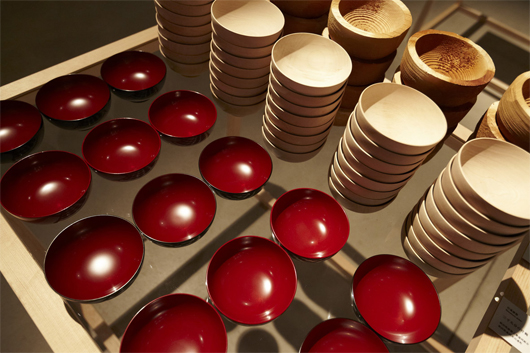MUSIC BY SCHILLER, EIN SCHÖNER TAG (WELTREISE)
Beginning April 27, 21_21 DESIGN SIGHT will present a new exhibition "TEMA HIMA: the Art of Living in Tohoku". It is a follow-up to last July's "THE SPIRIT OF TOHOKU: 'CLOTHING' BY ISSEY MIYAKE" held in the wake of the Great East Japan Earthquake.
 |
| POSTER |
This exhibition will focus on the "food and living spaces" of the Tohoku region as seen through the eyes of graphic designer Taku Satoh and product designer Naoto Fukasawa, two of the three directors of 21_21 DESIGN SIGHT (Issey Miyake is the third).
The Tohoku region in Northern Japan is renowned for its severe winters and uncharacteristically cool summers that make the lifestyle in the area very different from other parts of Japan. The exhibition presents works that speak from the heart. It offers artistic expressions of Tohoku's vitality, its people's admirable resilience and their ability to overcome numerous struggles. The collection of approximately 100 objects, photographs and videos on display prompts an immediate and compelling desire to find truth, reconnect to the cycles of Nature, let time unveil the essence of things and make things with your hands.
 |
| SOLITUDE |
A team of designers plus a food director, a journalist, a photographer and a film artist travelled around the six prefectures of Tohoku for three months. They visited environments and places where the degree of pretence is minimal and where people's stories may be raw and very old but they retain a special freshness and fragrance. The result of their research is a story told by objects, especially foods and utensils, and pictures of what they saw in Tohoku.
 |
| ART FROM THE HEART |
Tema Hima gives the impression that the curators penetrated the coarse and pulsating essence of things. They went back to the foundations of how these populations live. The group portrait that emerges is one of substance: farmers describing their traditions, craftspeople putting their own lives into their creations, and encounters with young local talents anxious to explore new production options. These intrinsically beautiful objects are not the product of individual genius, but of the collective force of tradition, an impersonal beauty that belongs to all.
 |
| WORK WITH YOUR HANDS |
These heartfelt expressions of everyday life are also a celebration of the Tohoku people. We human beings have built up a highly civilized society but in doing so we have had a great influence on the Earth's environment. The highly developed technologies change the circumstances not only in Nature and in comunication, but also in a moral dimensión.
 |
| 21_21 DESIGN SIGHT : Issey Miyake, Taku Satoh , Naoto Fukasawa. Musseum: Tadao Ando. |
21_21 DESIGN SIGHT, SEISMIC-RESISTANT AND RESILIENT ART
Interest and curiosity for Nature and the human being is a primitive step toward Natural Science. Recently, people are apt to be indifferent to Nature. We must understand the Earth´s past in order to look towards its future. Despite the great technological advances of civilization, we should look towards the natural.
The attitude we take towards Nature will invite us (or not) to face that part of the global responsibility which each person bears due to his participation, to whatever degree, in the social and economic life of our species. This participation, though scientific proof is still lacking, should bear an awareness of the consequences of atmospheric pollution caused by the chemical, radioactive, plastic, and oil industries that are released into the air. And this awareness must be promoted.
Governments are strongly urged to enforce corrective measures against the main culprits such as energy producers, transport systems and urban developers, so as to avert potential catastrophes. In today's world, our consciousness of our relationship to the elements of Nature is often subdued, relegated somewhere to the deep recesses of our awareness.
Governments are strongly urged to enforce corrective measures against the main culprits such as energy producers, transport systems and urban developers, so as to avert potential catastrophes. In today's world, our consciousness of our relationship to the elements of Nature is often subdued, relegated somewhere to the deep recesses of our awareness.
The interpretive and constructive character of human cognition is fully acknowledged, but the intimate, interpenetrating and all-permeating relationship of Nature to the human being and human mind allows the Kantian consequence of epistemological alienation to be entirely overcome.
The human spirit does not merely prescribe Nature's phenomenal order; rather, the spirit of Nature brings forth its own order through the human mind when that mind is employing its full complement of faculties, intellectual, volitional, emotional, sensory, imaginative, aesthetic, epiphanic. In such knowledge, the human mind "lives into" the creative activity of Nature.
Then the world speaks its meaning through human consciousness. Life goes on in Tohoku, but some things have been affected for ever. In this exhibition, we consider how the people in the region and Japan as a whole have responded to the events of 11 March 2011. Hand in hand to rebuild Tohoku. Two hands taking shape of a heart.
The human spirit does not merely prescribe Nature's phenomenal order; rather, the spirit of Nature brings forth its own order through the human mind when that mind is employing its full complement of faculties, intellectual, volitional, emotional, sensory, imaginative, aesthetic, epiphanic. In such knowledge, the human mind "lives into" the creative activity of Nature.
Then the world speaks its meaning through human consciousness. Life goes on in Tohoku, but some things have been affected for ever. In this exhibition, we consider how the people in the region and Japan as a whole have responded to the events of 11 March 2011. Hand in hand to rebuild Tohoku. Two hands taking shape of a heart.
The Tohoku winter is long, with everything blanketed in snow for months, and survival has always been a challenge for the locals. The objects and the foods in Tema Hima seem to have been produced in collaboration with Nature or out of resistance to it. Perhaps this is why they have the feel of winter, snow and the cold but also of affectionate warmth, fire and survival. They contain the beauty of real things and craftsmanship passed down through the generations.
2. RESILIENCE THROUGH PHOTOGRAPHY
 |
| TOHOKU PEOPLE, BEFORE AND AFTER, JUST ONE VIEW FROM A SINGLE PHOTOGRAPHY |
We've all seen Japanese people in our touristic countries portrayed as fervent camera enthusiasts. Apparently, this is not new. Are they really nuts about cameras? Japanese and cameras, the perfect couple: is it real or a stereotype? Resilience is much greater when you do what you know how to do it well. The evidence is here:
THE TOHOKU DISASTER PHOTOS
Resilience is the result of individuals being able to interact with their environments and the processes that either promote well-being or protect them against the overwhelming influence of risk factors. These processes can be individual coping strategies, or may be helped along by families, schools, neighbours, communities, and social policies that make resilience more likely to occur. Resilience can be viewed as the recovery from a prolonged or severe adversity, and its best vehicles can be art and culture, in Tohoku photography is also a therapeutic path as seen.
EYE SEE TOHOKU, RESILIENCE THROUGH PHOTOGRAPHY




No comments:
Post a Comment